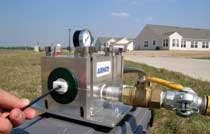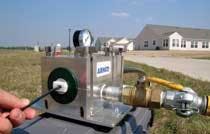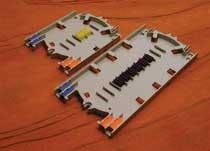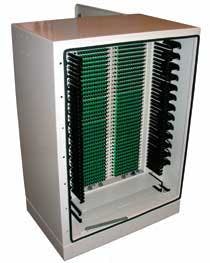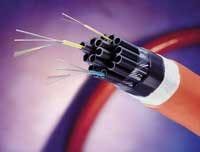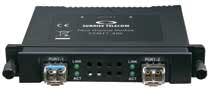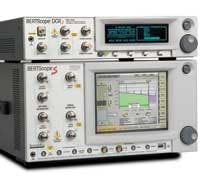Drop cable air-assist system
The AT 410 drop cable air-assist system is designed to quickly and efficiently install flat and round optical fiber and copper drop cables for residential and commercial FTTH and broadband applications. The drop air-assist system eliminates the need for pull tapes and ropes to install drop cable. While most drop services can be hand-pulled, the new system uses compressed air and an inflatable carrier, in combination with a standard wire or synthetic mesh grip, to pull the drop cable into the duct from the curb to the premises, providing quick installation of nonconnector and preconnector type drop cables using the air-pulling force of the inflatable carrier into ducts up to 1,000 ft. The system is available as a kit and is designed to work with most utility compressors 50 cfm or larger in ducts ranging from ½ inch to 1¼ inches.
ARNCO Corp., www.arncocorp.com
The FutureFLEX Air-blown Fiber (ABF) infrastructure product line now includes 24-fiber bundles, increasing capacity in each pathway by 33% for enterprise networks. The new fiber bundle also reduces labor time by eliminating an extra step in the fiber installation process. As ABF typically requires one-tenth the time and cost for fiber installation or any network moves, adds, or changes when compared to a traditional fiber-optic infrastructure, the introduction of the new fiber bundle further reduces costs. Unlike conventional cabling systems, fiber bundles blown out can be reused in other parts of the network, preserving the enterprise�s fiber investment. Since fiber upgrades require no construction work associated with �pulling� fiber, there is no disruption to operations or the facility.
Sumitomo Electric Lightwave, www.sumitomoelectric.com
The Series 3700 system switch/multimeter and plug-in card family, a next-generation platform of switching and integrated digital multimeter (DMM) test products, offers high-quality, instrument-grade switching for a variety of applications, including high-channel-count applications, with its ability to control up to 576 multiplexer channels in a six-slot, 2-U form factor. Four different mainframe options are available. The Series 3700 incorporates proprietary Test Script Processor (TSP) technology for creating test scripts that are embedded in and executed within the instrument. The system switch/multimeter is the first LXI Class B compliant system switch on the market. It includes a 10/100MBase-T Ethernet connection, LAN-based instrument triggering, and precision time protocol (PTP) synchronization for consistent time stamping and event coordination.
Keithley Instruments Inc., www.keithley.com
Optical node receiver
The Model OTPN-MDN-870 Advanced CATV Mini-Node has a wide optical input range from �8 to +4.5 dBm and a high RF output (+38 dBm per channel). The link accommodates up to 110 cable TV channels. The compact optical node receiver can be ordered to include an integral return path transmitter with 1,310-nm, 1,550-nm, and CWDM wavelength options. Standard connectors are SC/APC; FC/APC connectors may also be ordered. Advanced design features include a digitally adjustable attenuator and equalizer, eliminating the need to open the unit and exchange PADS and EQs. When used with Olson�s Model OTOT-870 CATV transmitter, the Mini-Node creates a high-performance, cost-effective, cable-TV fiber-optic distribution system.
Olson Technology Inc., www.olsontech.com
A 48-channel arrayed waveguide grating (AWG) covers all channels in the C-band with 100-GHz spacing, so it can serve as a universal AWG. This product allows users to consolidate systems that traditionally use different channel plans, according to the company. Targeting fiber to the home (FTTH), the company will focus on industry migration from 40-channel thermal AWGs to the 48-channel product.
Ignis Photonyx, www.ignis.com
Tunable transponder technology is moving from conventional 4-inch to smaller 3-inch MSA designs with higher integration density, which reduces space allocation and optical system cost. The newest lithium niobate (LiNbO3) XS-modulator platform achieves the same performance and reliability standards as the F10 product family, enabling 3-inch MSA transponders with high performance. In a compact design measuring 48 mm in package length, the modulator offers excellent electro-optic performance, low drive voltage, and low insertion loss. The small-form-factor modulator platform will support a variety of formats including optical duobinary, DPSK, and RZ.
Avanex Corp., www.avanex.com
The recently introduced MicroWSS 2x1 switch, based on a proprietary liquid-crystal optical processor, offers cost and performance advantages for two-degree ROADM nodes that are not supported with current wavelength-selective switch (WSS) architectures. As a three-port DWDM device, it can select any combination of wavelengths from an input port and an add port and direct these to a common output port, as well as individually equalize the optical power of each outgoing wavelength. Advanced modular free space optics enable virtually unlimited cascading.
Xtellus, www.xtellus.com
The 650 Series MicroTCA chassis is engineered for economical connectivity. An innovative power supply configuration reduces the cost of the chassis to half that of comparable products. The chassis, offered in a 2-U, 19-inch rack mount configuration, features a single 6HP MicroTCA Carrier Hub and a 12-node backplane. The backplane supports a range of customizable configurations for full- and half-height Advanced Mezzanine Card (AMC) slots.
Carlo Gavazzi Computing Solutions, www.gavazzi-computing.com
Compact optical line terminal
The compact optical line terminal (COLT) is the latest addition to the Trident7 product line. The Trident7 COLT is reportedly the industry�s only temperature-hardened OLT requiring only 2 RU of space, allowing network operators to deploy the COLT in inexpensive, non-climate controlled field cabinets to serve small pockets of up to 256 subscribers, assuming typical 32-way PON splits. The OLT can be deployed up to 70 km away from either a Trident7 Universal OLT or third-party multilayer switch in a central office or headend and can also extend network reach and push resiliency closer to the network edge. Trident7 is capable of delivering standards-based IEEE 802.3 GEPON (EFM PON) and ITU G.984 GPON triple-play services from a common platform.
Wave7 Optics, www.wave7optics.com
